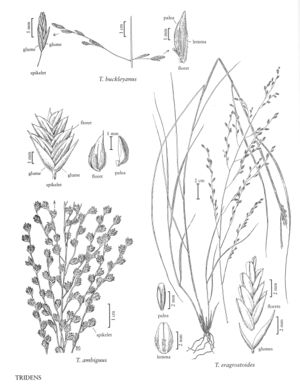Tridens eragrostoides
Plants cespitose, with knotty, shortly rhizomatous bases. Culms 50-100 cm; nodes sometimes sparsely bearded. Sheaths glabrous, scabrous, or sparsely pilose, rounded; ligules 1.2-3 mm, glabrous, membranous, usually lacerate; blades 10-15 cm long, 1.5-5 mm wide, scabrous (occasionally sparsely pilose), apices long-attenuate. Panicles 10-30 cm long, to 20 cm wide, open; branches 5-10(12) cm, lax, ascending to reflexed at maturity, proximal internodes longer than the distal internodes; pedicels (1.5)3-5 mm. Spikelets 3-7 mm, with 5-12 florets. Glumes glabrous, 1-veined, purple; lower glumes 2-2.5 mm; upper glumes 2-3.5 mm; lemmas 2-3.2 mm, veins puberulent to well above midlength, midveins sometimes excurrent, lateral veins rarely reaching the distal margins; paleas 1.5-2 mm, glabrous or scabrous basally, neither enlarged nor bowed-out; anthers 1-1.5 mm. Caryopses 1-1.3 mm. 2n = 40.
Distribution
N.Mex., Tex., Ala., Ark., Ariz., Fla.
Discussion
Tridens eragrostoides grows in brush grasslands, generally in partial shade. Its range extends from the southern United States into Mexico and Cuba.
Selected References
None.
